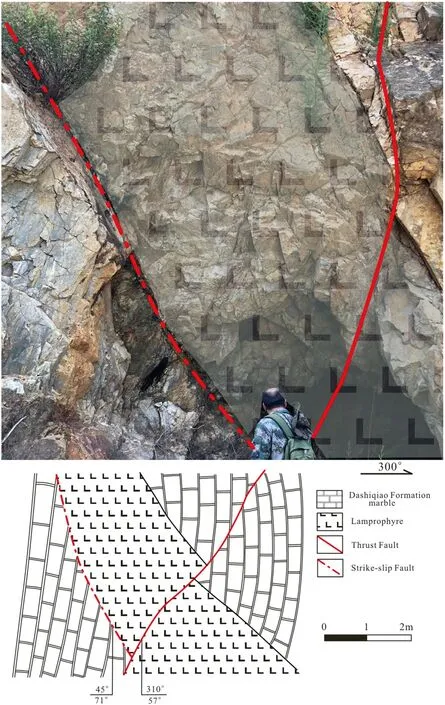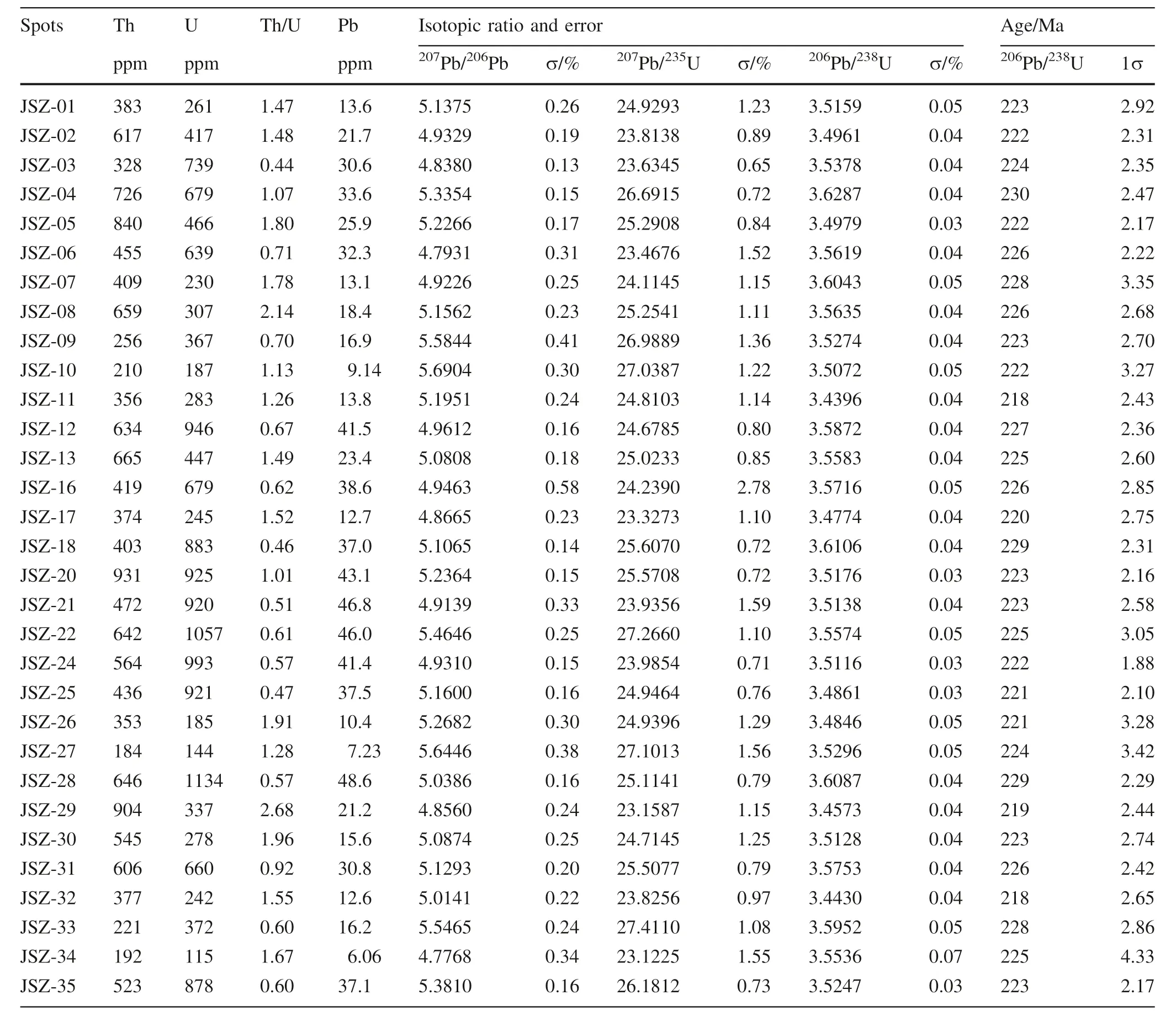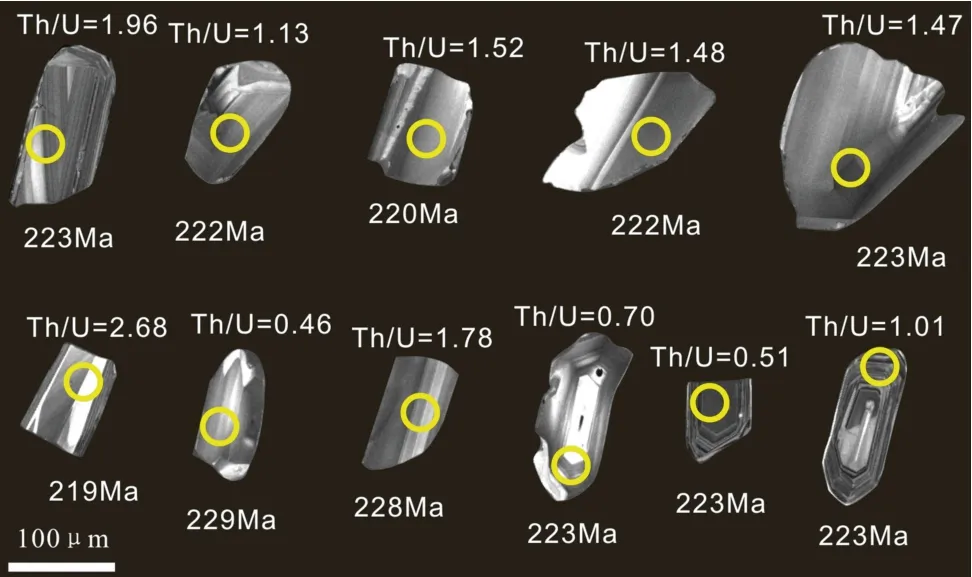Lower activity time constraint on the ore-controlling Erdaogou fault in the Qingchengzi orefield of the Liaodong Peninsula, NE China
2022-07-01YanZhaoYuewenFengPengZhangLinlinKouZhongzhuYangShenghuiLiWeiWang
Yan Zhao • Yuewen Feng • Peng Zhang • Linlin Kou • Zhongzhu Yang •Shenghui Li • Wei Wang
Abstract The Erdaogou fault,also known as the 101 fault,comprises the most important NE strike component in the ore-controlling system in the Qingchengzi orefield, Liaodong Peninsula.Due to the poor outcrop conditions in the field, the Erdaogou fault lacks activity time constraint.We demonstrate the constraint activity time of the fault since we observe a lamprophyre that was cut through by the Erdaogou fault in the Taoyuan area, central to the Qingchengzi orefield.Zircon grains from the lamprophyre dyke exhibit typical oscillatory zoning and yield weighted mean U–Pb age of 223.8 ± 1.1 Ma (MSWD = 1.5).The lower activity time limit of the Erdaogou fault is thus first constrained as 224 Ma or so and is correlated with the crystallization age of the Xinling and Shuangdinggou plutons within the orefield.Taking previous mineralization studies into consideration, a Triassic tectonic-magmatism-mineralization model is approved in the Qingchengzi orefield.
Keywords The Erdaogou fault ∙LA-ICP-MS ∙U–Pb dating ∙Activity time ∙The Qingchengzi orefield ∙Liaodong Peninsula
1 Introduction
As one of the most important gold product places in North China Craton, Liaodong Peninsula’s gold product place consists of the Qingchengzi, the Wulong, and the Maoling orefields.Among the three orefields, the Qingchengzi orefield,which has a gold reserve of over 300t(Wang et al.2017; Liu et al.2019; Zeng et al.2019), is the largest one.The NW trending Jianshan fault and the NE trending Erdaogou fault (also known as the 101 fault) are recognized as ore-controlling faults (Jiang and Wei 1989; Liu and Ai 1999;Ma et al.2012).Zhang et al.(2020)and other geologists studied the field structure features and concluded the Jianshanzi fault which had a long activity history, may just be a transmission path in gold mineralization.The NE trending Erdaogou fault which controls the Taoyuan gold deposit and other lead–zinc deposits lacks activity time constraint in this region.
Previous40Ar-39Ar dating in the Qingchengzi orefield yielded three stages of 225–204 Ma, 152–149 Ma, and 138–130 Ma respectively, while (U-Th)/He dating of zircon and apatites yielded a result of 125–40 Ma in the Qingchengzi orefield (Wang 2016).Compared to these thermochronological methods, zircon U–Pb analysis exhibit gorgeous advantages in precise dating and has succeeded in constraining structure activities limits in different areas(Zhang et al.2016a;Ma et al.2016;Xiao et al.2020).By detailed fieldwork, a lamprophyre dyke is observed cutting through by the Erdaogou fault in the Taoyuan area of the Qingchengzi orefield.To constrain the activity time of this fault and gold mineralization epoch in this orefield,the lamprophyre zircon grains were separated and their U–Pb ages were analyzed in this study.
2 Geological setting
Paleoproterozoic Liaohe Group meta-volcanic and metasedimentary rocks occupy the country rocks in the gold deposits (orefields) in the Liaodong Peninsula (Ma et al.2016;Zhang et al.2019;Zhao et al.2019;Sun et al.2020).As to the Qingchengzi orefield, the Gaixian and Dashiqiao formation schists are commonly country rocks.Previous studies focused on the metamorphism in ~1.9–1.85 Ga related to Paleoproterozoic orogeny process (Liu and Ai,2002; Liu et al.2019; Zhao et al.2020a,b).The NW and NE trending faults system,and the core complex system in this region are also studied (Sun et al.2019; Zhong et al.2020; Zhang et al.2021).
2.1 Structures
The country rocks mentioned above are severely folded in the Baiyun area, the northern part of the Qingchengzi orefield.While in the southern part, the fault system comprises the main structural frame.NW, NE, and EW trending faults are the predominant faults in the orefield.Among them, the Erdaogou fault which has a strike of 60°and a length of 15–20 km, is usually interpreted by geophysical researchers without exact geological evidence in the field.This NE striking fault comes into geologists’sight as a controlling fault on the distribution of gold and lead–zinc deposits in the Qingchengzi orefield.Almost all the lead–zinc deposits located in the south of the Erdaogou fault, and a newly discovered Taoyuan gold deposit and a silver-lead–zinc polymetallic deposit distribute a NE strike just follow the Erdaogou fault.Due to the poor fieldwork conditions, this important Erdaogou fault is even lack of activity constraint.The Jianshanzi fault,which has a strike of 330° and a dip angle of 60° to 80°, extends a length of 15 km in the southeastern of the orefield(Liu and Ai 1999).This fault has an early evolutionary stage of a dextral strike by previous studies on structures within the orefield (Liu and Ai 2002; Xue et al.2003).Up to 5 km strike fault distance is observed in the early activity stage of the Jianshanzi fault(Zhang et al.2020).This fault turns into a high-angle evolution stage after Triassic and keeps its activities for a certain time.
2.2 Intrusions
Paleoproterozoic and Triassic granitoids intrusions are the two main magmatic intrusions distributed in the Qingchengzi orefield (Fig.1).The Dadingzi monzogranite pluton in the southeast and the Yaojialing monzogranite pluton in the central area,both exhibit gold barren granites features, consist the Paleoproterozoic granitoid intrusions.The Xinling granitic pluton and the Shuangdinggou granitic pluton are believed to intrude into the Liaohe Group meta-sedimentary rocks in Triassic (Yu et al.2009;Zhang et al.2016b).Several relatively Mesozoic dykes,for instance, quartz diorites, lamprophyres are reported distributed within the orefield.The Xinling granitic pluton and NE trending granitic dykes in the central region exhibit weak pyritization and limonitization (Zhang et al.2016b;Song et al.2017).

Fig.1 Geological map of the Qingchengzi orefield showing the major deposits and faults system(after Wang et al.,2017)
2.3 Mineralization
The Qingchengzi orefield is famous for the giant gold,silver, and lead–zinc reserves in the Liaodong Peninsula.Gold deposits discovered in the twentieth century, for instance, the Linjiasandaogou, the Xiaotongjiapuzi, the Yangshu, the Maweizi, the Luoquanbei, all distributed in the west of the Jianshanzi fault and had an approximately NW strike distribution (Chen et al.2005; Ma et al.2013;Zhao et al.2020c).Gold-bearing sulfides, such as pyrite,arsenopyrite, and electrum, often exhibit as veins and aggregations along the foliation of the schist and gneiss country rocks therein.Previous studies focused on the relations between gold mineralization and the Jianshanzi fault as they had correlative spatial relationships (Liu and Ai 2002; Duan et al.2017).The discovery of the Taoyuan and the Maweizi gold deposits enable a rethink of the role the Jianshanzi fault played in gold mineralization.The NW trending fault maybe just a transmitting structure, the NE strike fault system may have controlled the gold mineralization in the orefield.Pb–Zn mineralization in the Qingchengzi orefield is classified as a Paleoproterozoic stratiform-type orebody overprinted by Mesozoic sulfides veins (Li et al.2020).The stratiform Pb–Zn mineralizations have occurrence correlated with the Liaohe Group meta-sedimentary rocks,while the Mesozoic sulfides veins are related to the tectonic-magmatism in the orefield(Wang et al.2020a, b).
3 Sampling and analytical method
The lamprophyre dyke intruded into the Dashiqiao Formation marbles in the Taoyuan region, central to the Qingchengzi orefield.The grey–black dyke intruded along the NE trending Erdaogou fault and was cut through by the NW strike Jianshanzi fault by field observation (Fig.2).The lamprophyre has a porphyritic texture.Plagioclase comprises the most phenocrysts and biotite comprises the main groundmass, with some accessory minerals such as apatite and sericite (Fig.3).

Fig.2 The lamprophyre dyke cut by the Er’daogou fault in the filed

Fig.3 The photomircograph of the lamprophyre dyke samples.Bt: biotite, Pl: plagioclase
Zircon grains were extracted from the lamprophyre and purified by hand-picking under a binocular microscope.The grains were mounted and polished before cathodoluminescent (CL) images were taken.U–Pb dating and trace element analysis of zircon were simultaneously conducted by LA-ICP-MS at the Wuhan SampleSolution Analytical Technology Co., Ltd., Wuhan, China.Laser sampling was performed using a GeolasPro laser ablation system that consists of a COMPexPro 102 ArF excimer laser (wavelength of 193 nm and maximum energy of 200 mJ) and a MicroLas optical system.The laser beam diameter was 35 μm and the repetition rate was 5 Hz.Each spot analysis consisted of ~5 s background measurement and 45 s of sample measurement.The207Pb/206Pb,206Pb/238U,207U/235U, and208Pb/232Th values were corrected for instrumental isotopic and elemental fractionation effects using zircon standard 91,500.An Excel-based software,ICPMSDataCal, was used to perform offline selection and integration of the background.It also analyzed signals,time-drift correction, and quantitative calibration for trace element analysis and U–Pb dating (Liu et al.2008).Concordia diagrams and weighted mean calculations were made using Isoplot/Ex_ver3 (Ludwig, 2003).
4 Results
CL images of representative zircons from the lamprophyre are shown in Fig.4.Zircon grains are subhedral to tabular shapes and are 60 to 150 μm long with aspect ratios of 1:1.5 to 1:2.These zircon grains exhibit marked oscillatory zoning in CL images, with Th/U ratios of 0.44 to 2.68(Table 1), indicating magmatic origin (Hoskin and Schaltegger, 2003).35 testing spots from the sample yielding Concordia ages of 223.8 ± 1.2 Ma(MSWD = 5),and weighted mean206Pb/238U age of 223.8 ± 1.1 Ma(MSWD = 1.5) (Fig.5, Table1).

Fig.5 Concordia diagrams and weightened ages for U–Pb analyses of zircons from the lamprophyre dyke studied

Table 1 LA-ICP-MS zircon U–Pb analyses for lamprophyre samples from Taoyuan area in the Qingchengzi orefield, Southern Liaoning province

Fig.4 CL images of typical zircons from the lamprophyre dyke studied.The 35-μm analytical spots,Th/U ratios and 207Pb/206Pb ages of LA ICP-MS analysis are also shown
5 Discussion
Previous studies focused on Mesozoic tectonic activities in East China, and conclude that the NE-NEE trending fault system was started at Triassic or Jurassic (Li et al.2004;Han et al.2018; Zhang et al.2020).The NEE trending Erdaogou fault in the Qingchengzi orefield is believed as a component of the system (Li et al.2004), but lacks of activity time constraint.
U–Pb isotopic dating study of the lamprophyre dyke gives a robust constraint on the lower activity time of the Erdaogou fault.Along the Erdaogou fault,the lamprophyre dyke intruded into the Paleoproterozoic strata by field observation in the Qingchengzi orefield.The lower activity time of the Erdaogou fault thus could be constrained by the geochronology of the dyke.Zircon grains from the lamprophyre dyke exhibit clear oscillatory zoning in CL images and tabular shapes, with Th/U ratios over 0.3,indicating a mafic magmatic origin (Hoskin and Schaltegger, 2003).Zircons from the lamprophyre yield a Concordia U–Pb age of 223.8 Ma.This result is consistent with the thermochronological study in the Qingchengzi orefield (Wang et al.2020a, b).The lower activity time of the Erdaogou fault is thus constrained for the first time as not earlier than 223.8 Ma.
The geochronological study is consistent with the geophysical study results in the Qingchengzi orefield.Several NW, NE, and EW trending main faults are inversed by gravitational and magnetic interpret (Fig.6, Wang et al.2020a).Also shown in this figure, the NE trending Erdaogou fault is stricken apart to the southeast by the NW trending Jianshanzi fault (Fig.6).The tectonic framework inversed by the geophysical studies also reveals the Mesozoic tectonic-magmatism-metallogenic events in the Qingchengzi orefield.The Jianshanzi fault, which has an NW strike and multi-activities,was reported as a long-lived normal fault overlaid on an early pre-Triassic dextral strike(Zhang et al.2020).Early tectonic studies in the Qingchengzi orefield focused on the Jianshanzi fault and suggested it as the ore-controlling fault (Zhao et al.2015;Yang et al.2016; Hao et al.2017), while recent studies revealed this NW strike fault only as an ore-transmitting structure (Zhang et al.2020).
The lower age limit of the Erdaogou fault is consistent with the Triassic magmatism-metallogenic events in the Qingchengzi polymetallic orefield.The Xinling granitic intrusion (225–224 Ma, Yu et al.2009; Duan et al.2014)and many contemporary granitic and lamprophyre dykes(227–210 Ma, Duan et al.2014; Zhang et al.2017; Zhou et al.2017) are reported recently (Fig.1) within the Qingchengzi orefield.Previous studies revealed that Triassic magmatism provided heat and related geo-fluids for the Pb–Zn and Au–Ag metallogenic process (Duan et al.2017; Zhang et al.2017).The ore-controlling Erdaogou fault,which has a NE striking,is correlated with the nearly EW strike fault system which is related to Triassic collision between the Yangze and North China cratons (Li et al.2005; Duan et al.2014) or collision between India and China continents (Deng and Wang 2016).Taking previous studies into account, a Triassic tectonic-magmatism-metallogenic model is approved in the Qingchengzi orefield.
6 Conclusions
Due to the zircon U–Pb analysis from the lamprophyre dyke in the Taoyuan area, the lower activity time of the Erdaogou fault is first constrained at 223.8 Ma.A Triassic tectonic-magmatism-mineralization system is approved in the Qingchengzi orefield.
AcknowledgementsThis work is financially supported by the National Key Research and Development Program of China (Grant No.2018YFC0603804, 2016YFC0600108), Geological Survey Project of China (Grant No.DD20190156), and the China Scholarship Council.Thanks to the reviewers and editors for their valuable reviews and suggestions.
Declarations
Conflict of interestThe authors declare that they have no conflict of interest.
Ethical approvalThe manuscript has not been submitted to more than one journal for simultaneous consideration.The manuscript has not been published previously(partly or in full),unless the new work concerns an expansion of previous work.A single study is not split up into several parts to increase the quantity of submissions and submitted to various journals or to one journal over time.No data have been fabricated or manipulated (including images) to support your conclusions.
杂志排行
Acta Geochimica的其它文章
- Application of low-temperature thermochronology on ore deposits preservation framework in South China: a review
- Timing of the formation of the Baiyinnuo’er skarn Zn–Pb deposit,NE China: evidence from sulfide Rb–Sr dating
- Timing of granite pegmatite-type high-purity quartz deposit in the Eastern Qinling, China: constraints from in-situ LA-ICPMS trace analyses of quartz and monazite U–Pb dating
- Geochronology and zircon geochemistry of auriferous intrusions in the Bumo deposit, Hainan Province, China
- Trace element and sulfur isotope compositions of pyrite from the Tianqiao Zn–Pb–Ag deposit in Guizhou province, SW China: implication for the origin of ore-forming fluids
- Ore-forming age and tectonic setting of the Linjiasandaogou gold deposit in the Liaodong Peninsula, northeast China: constraints from geochronology and geochemistry
